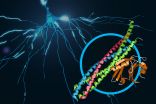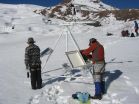(Press-News.org) Children with parents or caregivers currently serving in the military had a higher prevalence of substance use, violence, harassment and weapon-carrying than their nonmilitary peers in a study of California school children, according to an article published online by JAMA Pediatrics.
While most young people whose families are connected to the military demonstrate resilience, war-related stressors, including separation from parents because of deployment, frequent relocation and the worry about future deployments, can contribute to struggles for some of them, according to the study background.
Kathrine Sullivan, M.S.W., of the University of Southern California School of Social Work, Los Angeles, and coauthors analyzed data collected in 2013 that included 54,679 military-connected and 634,034 nonmilitary-connected secondary school students from public civilian schools in every county and almost all the school districts in California. Students were defined as military connected if they had a parent or caregiver currently serving in the military. Latino students were the largest percentage of the sample (51.4 percent) and 7.9 percent of students indicated having a parent in the military, according to the results.
The results indicate military-connected students reported higher levels of lifetime and recent substance use, violence, harassment and weapon-carrying compared with nonmilitary-connected students. For example:
45.2 percent of military-connected youth reported lifetime alcohol use compared with 39.2 percent of their nonmilitary-connected peers
12.2 percent of military-connected youth reported recently smoking cigarettes in the previous 30 days compared with about 8.4 percent of their nonmilitary peers
62.5 percent of military-connected students reported any physical violence compared with 51.6 percent of nonmilitary-connected students
17.7 percent of military-connected youth reported carrying a weapon at school compared with 9.9 percent of nonmilitary students
11.9 percent of military-connected students reported recent other drug use (e.g., cocaine and lysergic acid diethylamide [LSD]) compared with 7.3 percent of nonmilitary peers
The authors note the data they used were cross-sectional and therefore cannot infer causality. The data also come from a self-report survey and students may have been reluctant to report risky behavior.
"Based on the totality of findings from this study and others, further efforts are needed to promote resilience among military children who are struggling. More efforts in social contexts, including civilian schools and communities, to support military families during times of war are likely needed," the study concludes.
INFORMATION:
(JAMA Pediatr. Published online August 17, 2015. doi:10.1001/jamapediatrics.2015.1413. Available pre-embargo to the media at http://media.jamanetwork.com.)
Editor's Note: Please see article for additional information, including other authors, author contributions and affiliations, etc.
Media Advisory: To contact corresponding author Kathrine Sullivan, M.S.W., call Eddie North-Hager at 213-740-9335 or email edwardnh@usc.edu
Menlo Park, Calif. -- Scientists have revealed never-before-seen details of how our brain sends rapid-fire messages between its cells. They mapped the 3-D atomic structure of a two-part protein complex that controls the release of signaling chemicals, called neurotransmitters, from brain cells. Understanding how cells release those signals in less than one-thousandth of a second could help launch a new wave of research on drugs for treating brain disorders.
The experiments, at the Linac Coherent Light Source (LCLS) X-ray laser at the Department of Energy's SLAC National ...
Adversity during the first six years of life was associated with higher levels of childhood internalizing symptoms, such as depression and anxiety, in a group of boys, as well as altered brain structure in late adolescence between the ages of 18 and 21, according to an article published online by JAMA Pediatrics.
Both altered brain structure and an increased risk of developing internalizing symptoms have been associated with adversity early in life.
Edward D. Barker, Ph.D., of King's College London, and coauthors examined how adverse experiences within the first six ...
Legislative efforts by the state of Florida to reduce prescription drug abuse and diversion appear to be associated with modest decreases in opioid prescribing and use, according to an article published online by JAMA Internal Medicine.
Prescription opioids provide necessary pain relief to millions of Americans but rates of opioid diversion, addiction and overdose deaths have soared since the mid-2000s. Florida was at the epicenter of this problem. In 2010, the Florida legislature addressed so-called pill mills or rogue pain management clinics where prescription drugs ...
Presymptomatic patients with the neurodegenerative disease amyotrophic lateral sclerosis (ALS) consumed more daily calories but had lower body-mass index (BMI) than those individuals without ALS in a study in the Netherlands that also looked at risk for the disease and associations with food and alcohol intake, according to an article published online by JAMA Neurology.
The cause of ALS is poorly understood. Diet is highly modifiable but previous studies have not identified a consistent nutrient that modifies susceptibility to ALS and contradictory results exist for the ...
Prior to the advent of human-caused global warming in the 19th century, the surface layer of Earth's oceans had undergone 1,800 years of a steady cooling trend, according to a new study. During the latter half of this cooling period, the trend was most likely driven by large and frequent volcanic eruptions.
An international team of researchers reported these findings in the August 17, 2015 issue of the journal Nature Geoscience. The study also indicates that the coolest temperatures occurred during the Little Ice Age--a period that spanned the 16th through 18th centuries ...
CHICAGO --- Some stressful experiences - such as chronic childhood abuse - are so overwhelming and traumatic, the memories hide like a shadow in the brain.
At first, hidden memories that can't be consciously accessed may protect the individual from the emotional pain of recalling the event. But eventually those suppressed memories can cause debilitating psychological problems, such as anxiety, depression, post-traumatic stress disorder or dissociative disorders.
A process known as state-dependent learning is believed to contribute to the formation of memories that ...
17.08.2015: Glaciers in Central Asia experience substantial losses in glacier mass and area. Along the Tien Shan, Central Asia's largest mountain range, glaciers have lost 27% of their mass and 18% of their area during the last 50 years. An international research team led by the GFZ German Research Centre for Geosciences and including the institute of the French Centre National de la Recherche Scientifique (CNRS) at Rennes University in particular, estimated that almost 3000 square kilometres of glaciers and an average of 5.4 gigatons of ice per year have been lost since ...
Lueneburg. Sustainability Scientists at Leuphana University of Lueneburg have devised a simple screening-based predicting procedure for region-specific environmental risks caused by veterinary antibiotics (VA). This procedure, called Usage Pattern-based Exposure Screening (UPES), makes use of utilization patterns of antibiotics in animal husbandry. By improving targeting, it enables the identification of particularly problematic antibiotic substances. It also enables the implementation of more advanced risk prediction tests, for example with the help of soil and water ...
DURHAM, N.C. -- We've all seen dewdrops form on spider webs. But what if they flung themselves off of the strands instead?
Researchers at Duke University and the University of British Columbia have now observed this peculiar phenomenon, which could benefit many industrial applications. As long as the strands are moderately hydrophobic and relatively thin, small droplets combining into one are apt to dance themselves right off of the tightrope. The discovery could form the basis of new coalescer technologies for water purification, oil refining and more.
The findings ...
Seasonal water shortages already occur in the Central Andes of Peru and Bolivia. By the end of the century, precipitation could fall by up to 30% according to an international team of researchers led by the University of Zurich. In a first for this region, the team compared current climate data with future climate scenarios and data extending back to pre-Inca times.
The population in the Central Andes already faces water shortages today. Now geographers at the University of Zurich have collaborated with Swiss and South American researchers to show that precipitation in ...


